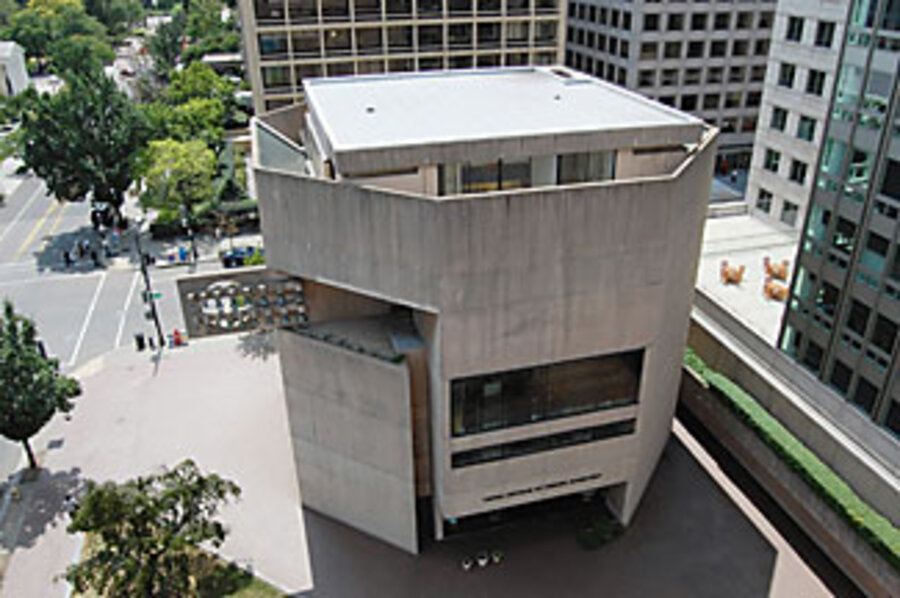'Historic' building versus religious rights
Loading...
In Washington, D.C., Third Church of Christ, Scientist is the lead actor in a saga playing out in cities across the US.
Local communities seeking to preserve historic buildings are contending with religious congregations that, for financial or other reasons, want to modify or tear down their buildings. The clashes have intensified since the 1990s with the passage of federal laws aimed at protecting religious institutions from land-use restrictions that interfere excessively with their "free exercise" of religion.
The Christian Science congregation, located just blocks from the White House in a unique building of modernist architecture, wants to demolish the structure and build a new church that is more energy-efficient and suitable for its needs.
"We want a church that is welcoming and fits the scale of the community, one that does not give the secretive, enclosed impression that this Brutalist building does," says J. Darrow Kirkpatrick, the church's coordinator for redevelopment.
But the District of Columbia's historic preservation board designated the church a historic landmark in December 2007 specifically because it is a strong example of Brutalism, an architectural style involving raw concrete and monolithic forms. In July 2008, the board turned down the church's request to raze the building.
In response, Third Church has filed a lawsuit in federal court challenging the landmark restriction, alleging violation of two religious freedom laws and the Free Exercise clause of the First Amendment.
Under the Religious Land Use and Institutionalized Persons Act of 2000 (RLUIPA), for instance, when a religious group shows that a ruling would create "a substantial burden," officials must show they have a "compelling interest" for doing so. Third Church says that no compelling interest has been demonstrated.
Not only is the building too costly to maintain (i.e., requiring $8,000 in scaffolding to change light bulbs), the church says, but it is also not representative of its theology. And the church is being prevented from worshiping as it wants to.
As part of the historic preservation process before the case proceeds in court, District of Columbia city planner Harriet Tregoning is considering whether the refusal to allow demolition could result in "unreasonable economic hardship" for the church. If Ms. Tregoning finds that to be the case, she could decide as soon as late January to allow the demolition. If not, the case will move to the courts.
Although the 37-year-old building is too new to be designated historic in most jurisdictions (50 years is the norm), a group of local architects and preservationists sought the landmark status starting in 1991. They have offered to help the church consider various uses for the building to help pay for the expensive maintenance, from including gallery space to adding an office building above it.
"We have offered to meet with them on numerous occasions and are more than willing to entertain opportunities for the site," says Rebecca Miller, executive director of the D.C. Preservation League.
The church sits on property owned by ICG Properties, which proposes including a smaller church on the land along with an office building. The fortresslike design has been controversial from the start, among architects and the public. A neighborhood commission voted unanimously to support the church's desire to rebuild.
The suit to overturn the landmark decision is one of the first under RLUIPA dealing with historic preservation.
"Even though these disputes are astonishingly common, they frequently get negotiated privately ... or get settled by the church tearing the building down before it is landmarked," says Julia Vitullo-Martin, a senior fellow at the Manhattan Institute, a market-oriented think tank in New York. St. Bartholomew's in New York, however, lost an 11-year battle over its community house in 1991.
The D.C. case is particularly interesting because the building doesn't fit the traditional "historic" category and because the congregation says it doesn't reflect its theology, Ms. Vitullo-Martin says. "Making the claim that the Brutalism of the architecture is at odds with their theology is an unusual First Amendment claim."
Yet it's far from certain the church can win in the courts, legal experts say. While there are no litigated historic preservation cases under RLUIPA, there are prior cases under other religious freedom laws.
"I find the church's claim very sympathetic, but courts have been fairly skeptical about claims that a congregation is 'substantially burdened,'" says Robert Tuttle, professor of law at George Washington University. As a technical phrase, that means "the restriction makes the religious activity effectively impracticable."
The courts tend to say, he adds, that if there are alternative uses for the structure, the church could use it as it is or go elsewhere and build another however it likes.
That is not what Third Church has in mind. It has worshiped in downtown locations within blocks of the White House since 1918. (Originally, the congregation met in a building shared with the National Woman's Party on Lafayette Square.) Although they've already spent more than $100,000 "out of the collection plate," the members are staying with their case, says Mr. Kirkpatrick. "No one wants to leave the corner [of 16th and I Streets] and our downtown mission since 1918."





